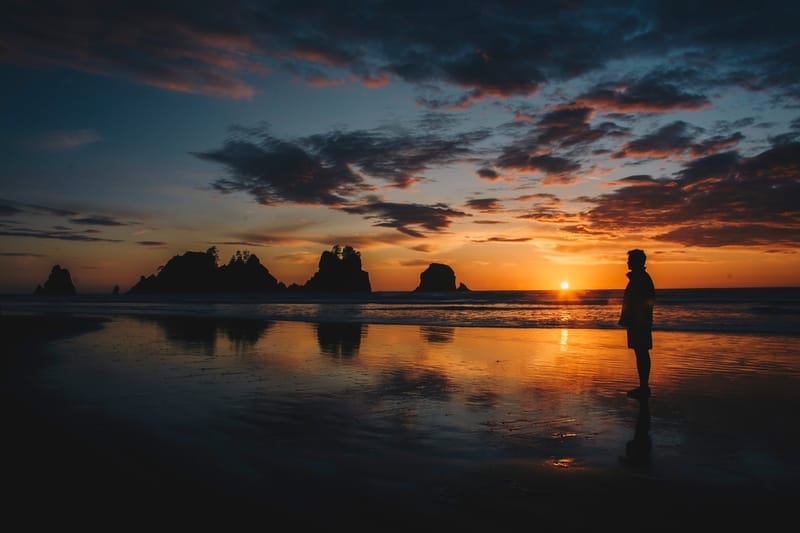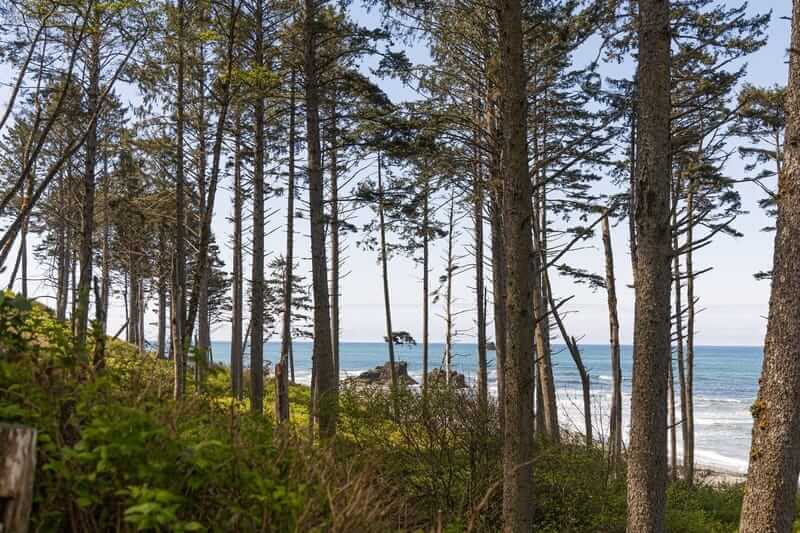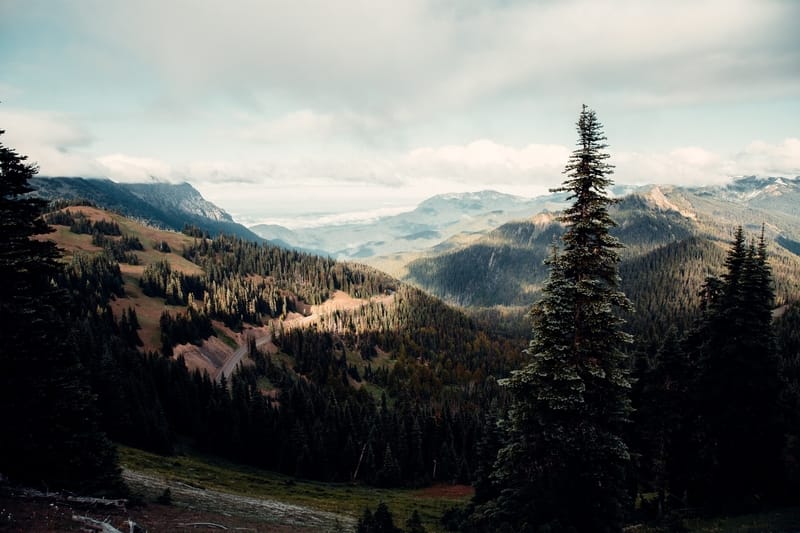Located on the western peninsula of Washington State, Olympic National Park is one of the most majestic and diverse parks in the United States. It’s one of America’s only national parks where you can find a wide array of ecosystems and topography. With over 1 million acres of protected land, outdoor enthusiasts could spend an entire season hiking around this national park and still not scratch the surface of things to do and see.
While plenty of adventure awaits, some key hikes can’t be missed. Our list of the best hikes in Olympic National Park covers the region’s varied terrain so you can experience its rainforests, mountain peaks, and peaceful meadows, all within a long weekend.
Where is Olympic National Park?
Olympic National Park is located in the Pacific Northwest – which is home to some of the prettiest terrain in the United States. Olympic National Park is situated just outside Seattle, Washington, on the Olympic Peninsula. It takes up a good portion of the state’s northwest corner and is bordered by the Pacific Ocean to the West and the Salish Sea to the North. Various access points allow for ease of navigation to this large park. Utilize Google maps to find your way around and you shouldn’t have a problem.
Why Hike in Olympic National Park?
Hiking in Olympic National Park is an aspiration many trekkers have on their travel bucket lists. Known for its unique variations of plant and animal life, Washington State’s crown jewel is one of the best places in the country for hiking. You may find yourself on a high alpine ridgeline one morning, taking in panoramic views of surrounding mountainscapes. That evening, you can relax beachside while looking out at the ocean to spy humpback whales breaching the blue water. The next day, you can opt to find a hiking trail in a temperate rainforest.
What to Know Before Hiking in Olympic National Park
- When is the best time to visit? Spring, summer, and fall are the best times to visit Olympic National Park. Otherwise, one must be attentive to road and trail closures. If you wish to visit during the winter months to take advantage of the park’s miles of hiking trails, call the visitor center to inquire about accessible trails.
- Be prepared for changing weather. Because the terrain and climates are so varied throughout the park, it’s crucial to pack a gear range that can handle wet slopes, muddy rivers, cold mornings, and intense midday sun.
- Lodging is limited. There are only two places to stay within the park if you’re looking for comfortable accommodations. However, as this is a national park, camp spots are plentiful. Certain areas like Fairholme, Kalaloch, Mora, and Hoh Rainforest accept summertime reservations, but others are first-come, first-serve. Backcountry campsites may be more attainable on short notice for those willing to work for them. Plan your stay ahead of time to know what to expect upon arrival.
- Summer crowds. The peak season for this national park is June to August. The trail head of a popular hike may be completely full as early as sunrise. Camping may be limited. Traffic in and out of the park might also eat up your spare time. Plan accordingly and get ready for some early mornings to beat the crowds and the heat.
Table of Contents
Most Popular Hikes in Olympic National Park
Trail name: Hoh River Trail

Image Source: Unsplash
- Location: Hoh Rain Forest
- Trail Length: 17.4 miles round trip
- Trail Type: Out-and-back
- Trail Difficulty: Medium to Hard
- Estimated Time: TBD
Hoh River Trail is one of the most sought-after hikes in this national park because of its dynamic nature and location. Most of the 17.4 miles pass through the lush Hoh Rain Forest, meandering through thick trees and alongside babbling brooks. Those desiring a shorter distance can turn around when they’ve walked their fill of this popular trail. Backpackers can travel the entire length of this trail and end up at the base of Mount Olympus and its Blue Glacier.
Even though this trail is rated for more intermediate hikers, many trails spur off the main stretch, allowing families to experience this majestic slice of paradise without pushing their little ones too hard. This lush rainforest trail is popular for bird watching. Opportunities for bird enthusiasts to catch sightings of lesser-seen birds are numerous in this area of Olympic National Park.
Trail name: Rialto Beach to Hole-in-the-Rock

Image Source: Unsplash
- Location: Rialto Beach
- Trail Length: 1.5 miles
- Trail Type: Out-and-back
- Trail Difficulty: Easy
- Estimated Time: 1 hour
This short tour continuously collects a gaggle of sun chasers at the end of each day. Start at the parking area for Rialto Beach and travel an easy mile and a half with minimal elevation gain to the stunning feature appropriately named Hole-in-the-Rock. Snap pictures of rippling tide pools and exciting rock formations bathed in golden light.
Trail name: Hurricane Ridge Trail to Hurricane Hill Trail

Image Source: Unsplash
- Location: Hurricane Ridge Visitor Center
- Trail Length: 1.6 miles
- Trail Type: Out-and-back
- Trail Difficulty: Easy
- Estimated Time: 1 hour
Starting from the visitor center, travel along a wide, even path up moderately graded switch-backs and absorb postcard-worthy views. Small children and extremely beginner hikers can tackle this hiking trail with no problem and get treated to million-dollar views while barely breaking a sweat. At under a mile hike each way, those wishing to avoid a strenuous hike can choose this one instead.
Trail name: Sol Duc Falls Trail

Image Source: Unsplash
- Location: Sol Duc
- Trail Length: Approximately 1 mile
- Trail Type: Out-and-back
- Trail Difficulty: Easy
- Estimated Time: 1 hour
This accessibility of Sol Duc Falls, at less than a mile in, makes this one of Olympic National Park’s most popular trails. For those planning a trip to the northwest section of the park, this pretty stretch of lush old-growth forest is on your must-see list. Experienced hikers will delight in this easy day trip and can rest weary legs with minimal feet of elevation gain on this out-and-back hike in a lush rainforest.
Easy to Moderate Hikes in Olympic National Park
Trail name: Sunrise Ridge via Sunrise Point Trail

Image Source: Unsplash
- Location: Hurricane Ridge Road Parking Lot
- Trail Length: 3 miles
- Trail Type: Out-and-back
- Trail Difficulty: Easy
- Estimated Time: 2 hour
Start at High Ridge Trail and warm up those legs with a semi-steep climb up to a breathtaking viewpoint. This trail travels East towards Mount Angeles. Don’t get confused by the name change halfway; this trail may also be marked as Sunrise Point Trail or Klahhane Ridge Trail. Between outstanding views, keep an eye out for mountain goats clinging to the steep, rocky walls.
Trail name: Marymere Falls

Image Source: Unsplash
- Location: Storm King Ranger Station
- Trail Length: 1.8 miles
- Trail Type: Out-and-back
- Trail Difficulty: Easy
- Estimated Time: 1.5 hours
Travel through an old-growth forest on your way to this tumbling waterfall. The majority of the hike is on flat terrain until the last stretch, which leads hikers up a steep climb to an epic viewpoint of Marymere Falls.
Trail name: Shi Shi Beach

Image Source: Unsplash
- Location: Makah Reservation
- Trail Length: 6 – 10 miles
- Trail Type: Out-and-back
- Trail Difficulty: Easy to Moderate
- Estimated Time: TBD
Visitors to Washington’s beautiful national park can opt to visit Shi Shi Beach and take part in a choose-your-own-adventure style hike. First, you must purchase a Makah Recreation Pass and a park pass. Decide if you’ll be camping on the beach or just want to go out for a day stroll.
Trail name: Cape Flattery

Image Source: Unsplash
- Location: Northernmost point of the U.S.
- Trail Length: 1.5 miles
- Trail Type: Out-and-back
- Trail Difficulty: Easy
- Estimated Time: 1 hour
Find this trail where the Pacific Ocean meets the Strait of Juan de Fuca. Follow along the level trail and enjoy three spectacular viewpoints. A combination of gravel, dirt road, and boardwalk, choose this hike for a day when your legs need a break.
Difficult Hikes in Olympic National Park
Trail name: Mount Storm King

Image Source: Unsplash
- Location: Storm King Ranger Station
- Trail Length: 4.6 miles
- Trail Type: Out-and-back
- Trail Difficulty: Hard
- Estimated Time: 4 – 5 hours
The short and steep Mount Storm King hike hike puts the toughest of hikers to the test. Your legs will feel the burn of the almost unrelenting elevation gain of over 2,000 feet. Hikers will need to pull themselves up the steepest section via ropes toward the summit. Take your time at the top of Mount Storm King to enjoy stunning views of Lake Crescent and maybe a cold beer you packed in from one of Seattle’s local breweries.
Trail name: Kalhhane Ridge Trail to Mount Angeles

Image Source: Unsplash
- Location: Extension of Sunrise Ridge Trail
- Trail Length: 6.5 miles
- Trail Type: Out-and-back
- Trail Difficulty: Difficult
- Estimated Time: 4 – 5 hours
This is one of the more popular, challenging hikes in the park because of its spectacular views of Mount Angeles. Continue down the Sunrise Ridge Trail past its turnaround point and enjoy a brief descent before some real work begins. Carefully scramble up the steep incline that leads to the summit of Mount Angeles. With no clouds in the forecast, hikers can witness expansive views encompassing Washington’s most famous landmarks – Vancouver Island, Puget Sound, and even the snow-capped mountains that contain Mount Rainier.
Trail name: High Divide Trail and Seven Lakes Basin Loop

Image Source: Unsplash
- Location: Sol Duc Falls
- Trail Length: 19 miles
- Trail Type: Out-and-back
- Trail Difficulty: Difficult
- Estimated Time: All day or overnight hike
If you don’t like the idea of sleeping overnight in the backcountry, plan for a big day. This 19 miles trek covers a multitude of terrain, including subalpine and alpine regions. Upon passing Deer Lake, keep an eye out for various wildlife, including black bears, deer, mountain goats, etc. Need to cool off? Take a dip in one of these stunning alpine lakes.
Trail name: Mount Ellinor Trail

Image Source: Unsplash
- Location: Lower Trailhead Access or Upper Trailhead Access
- Trail Length: 6.2 or 3.2 miles
- Trail Type: Out-and-back
- Trail Difficulty: Moderate to Difficult
- Estimated Time: 2 – 4 hours
Depending on your hiking ability, this trail may be moderately challenging or very difficult. Seasoned trailhounds can opt for the longer version which has a moderate climb or the shorter version which covers less terrain but uses steep switchbacks to access the summit. Stop along one of the numerous trail-side benches to catch your breath or enjoy a picnic lunch.
What to Bring on a Day Hike
Regardless of the trail you wish to travel down, you should always pack the following items in your daypack in case of emergency.
- Plenty of water. Even though the environment is moist and often shady, bring an appropriate amount of water, and then a little more. Bring at least two liters per person unless you have a way to filter water from natural features.
- Snacks. Food is fuel for the body, and we can’t get very far without it. It’s important to replenish along the way or you may find yourself taking twice as long on the way back. The body uses glucose as an energy source, but it quickly burns through these reserves and needs replenishment.
- Emergency first-aid kit. From small cuts to significant sprains, a first-aid kit can be make-it or break-it in the backcountry. Ensure yours is well stocked with bandages, clotting powder, antiseptic, and even sutures. For those going on longer treks, you might consider investing in a satellite GPS with an emergency alert.
- Extra layers. Mornings and evenings in Washington State, especially along the coast, can dip in temperature, necessitating a warm layer. Don’t forget to pack a raincoat and an extra thermal layer. Having the proper hiking pants is also smart.
- Hiking Boots. A sturdy pair of hiking boots (or hiking sandals) can carry you over rough terrain. A waterproof pair of hiking boots can even allow you from the muddy banks of Lake Angeles to the steep Hurricane Ridge Road.
- Bear Spray. For those who haven’t checked a mountain hike off their bucket list, don’t forget to pack the bear spray. Black bears can be found in all sections of the park – even at the park’s rugged beaches.
How to get to Olympic National Park
Getting there is easy with Seattle just next door. Although, depending on your point of origin, a drive through this part of the country may be the best mode of transportation. Fly into Seattle and rent a car, or take a bus to the park. From there, it’s easy to get around if you are planning to camp in the park.
The Washington State Ferry System provides multiple boats that depart from Puget Sound and take visitors to the Olympic Peninsula. You may even consider taking the ferry as part of your sight-seeing tour as these daily boat rides offer fantastic views of the surrounding mountains and sea.
Weather Conditions in Olympic National Park
During the summer months, conditions are warm and dry, making it a popular season to visit this pristine piece of paradise. Winter often brings snow and a fair amount of it. Spring and fall are moist with increased precipitation, treating visitors to pretty natural views and crisp mornings.
Where to stay near Olympic National Park
Outside Olympic National Park.
Fortunately, there are plenty of places to stay near Olympic National Park, depending on your transportation situation. Those wishing to experience some nightlife and fine dining can stay in Seattle and enjoy a pretty drive into the park each day. Port Angeles, Sequium, or Port Townsend also offer small-town vibes and are not far from the gates of the national park.
Within the National Park
If you’re looking to stay in the National Park, book a few nights at Sol Duc Hot Spring Resort. Rest sore muscles with dips in the natural hot springs and wake up recharged and ready to tackle a new trail. Lake Crescent Lodge, built in the early 1900’s, offers a historic hotel experience right on the banks of its namesake.
If you haven’t yet visited the Pacific Northwest region of the United States, there’s no time like the present. The Pacific Coast is home to numerous captivating plant and animal species, charming seaside towns like Port Angeles, snow capped mountains like Mount Baker, and wild trails that lead from tidal pools to 7,000 foot peaks.


Leave a Reply